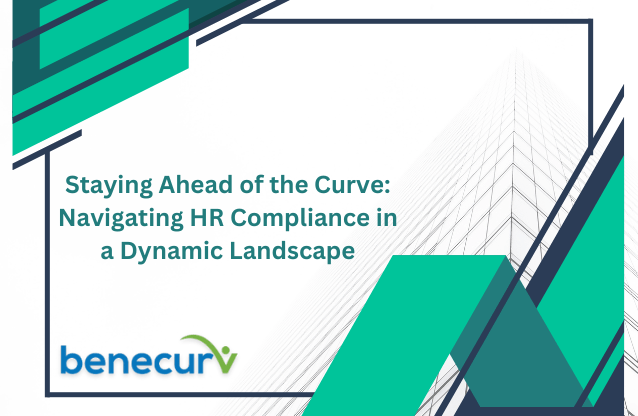In today’s rapidly evolving business environment, navigating HR compliance effectively is more crucial than ever. Constant changes in regulations, evolving technology, and shifting workforce demographics necessitate an agile and proactive approach to ensure legal compliance and a positive work environment. This comprehensive guide empowers businesses to stay ahead of the curve in HR compliance, offering practical strategies for understanding emerging trends, adapting to change, and building a resilient compliance framework.
How to Stay Ahead of the Curve: Navigating HR Compliance in a Dynamic Landscape
Understanding the Dynamic Landscape:
Several key factors contribute to the dynamic nature of HR compliance:
- Legislative Changes: New laws and regulations are constantly being introduced or amended at the federal, state, and local levels, requiring businesses to stay updated and adjust their practices accordingly.
- Technological Advancements: New technologies like artificial intelligence (AI) and automation present both opportunities and challenges for HR practices, demanding careful consideration of their legal and ethical implications.
- Shifting Workforce Demographics: The evolving composition of the workforce, with an increasing emphasis on diversity, inclusion, and remote work arrangements, necessitates adapting HR policies and practices to cater to these evolving needs.
- Increased Legal Scrutiny: Heightened awareness of employee rights and increased legal challenges require businesses to be extra vigilant in ensuring their compliance practices are robust and well-documented.
Staying Ahead of the Curve:
To navigate this dynamic landscape effectively, businesses can adopt the following strategies:
- Proactive Monitoring and Awareness:
- Subscribe to reliable HR compliance resources: Stay informed by subscribing to newsletters, attending webinars, and participating in industry associations.
- Establish internal communication channels: Encourage open communication and employee feedback to identify potential compliance issues early on.
- Embrace a Culture of Compliance:
- Integrate compliance into your core values: Foster a culture where compliance is prioritized and valued by all employees and leadership.
- Invest in employee training: Regularly train employees on relevant HR policies, legal updates, and their rights and responsibilities.
- Leverage Technology:
- Utilize HR management software: Automate routine tasks, streamline compliance processes, and track key metrics to identify potential risks.
- Explore AI-powered solutions: Implement AI-powered tools to analyze data and identify potential compliance issues proactively.
- Seek Expert Guidance:
- Partner with HR professionals or legal counsel: Utilize the expertise of HR professionals or legal counsel to navigate complex compliance issues and ensure a proactive approach.
- Engage with industry experts: Seek guidance from industry experts and consultants specializing in HR compliance trends and best practices.
Building a Resilient Compliance Framework:
Developing a robust and adaptable compliance framework is essential for navigating a dynamic landscape. Here are key considerations:
- Conduct Regular Compliance Audits: Regularly conduct internal audits to identify potential gaps and vulnerabilities in your compliance practices.
- Maintain Comprehensive and Up-to-Date Documentation: Maintain thorough and accessible documentation of all policies, procedures, and compliance processes.
- Develop a Crisis Management Plan: Establish a plan outlining how to respond to potential HR compliance disputes or legal challenges swiftly and effectively.
- Adapt and Refine Continuously: Regularly review your HR compliance strategy, adapt to changing legal requirements, and refine your approach based on ongoing monitoring and feedback.
Addressing Emerging Trends:
By proactively addressing emerging trends, businesses can further strengthen their compliance posture and stay ahead of the curve. Here are some key trends to consider:
- Remote Work and Global Expansion: As remote work models become more prevalent and global expansion trends continue, businesses need to ensure compliance with relevant labor laws and regulations across different jurisdictions.
- Diversity, Equity, and Inclusion (DE&I): Heightened focus on DE&I necessitates reviewing and revising policies and practices to remove potential bias and ensure equal opportunities for all employees.
- Data Privacy and Cybersecurity: With increasing use of employee data, businesses need to implement robust data privacy and cybersecurity measures to comply with regulations and protect sensitive information.
Conclusion:
Navigating HR compliance in a dynamic landscape requires constant vigilance, adaptability, and a proactive approach. By staying informed, embracing a culture of compliance, leveraging technology, seeking expert guidance, and building a resilient compliance framework, businesses can navigate this evolving landscape effectively. Addressing emerging trends proactively further strengthens a business’s compliance posture and positions them for success in the long run.
Remember, prioritizing HR compliance is not just about avoiding legal repercussions; it’s about fostering a fair, ethical, and positive work environment for your employees. By actively engaging with compliance and building a robust framework, you can attract and retain top talent, build stronger relationships with your workforce, and pave the way for sustainable business growth.
FAQs:
Q: What are the potential consequences of non-compliance with HR regulations?
A: Non-compliance can lead to severe consequences, including financial penalties, legal repercussions, reputational damage, and even business closure in extreme cases.
Q: How can small businesses effectively manage HR compliance on a limited budget?
A: Many free or low-cost resources are available online and through government agencies. Consider partnering with other small businesses to utilize shared resources or co-op legal counsel.
Q: Who is ultimately responsible for ensuring HR compliance within a business?
A: While leadership holds ultimate responsibility, compliance is a shared responsibility involving HR professionals, managers, and all employees. Fostering a culture of compliance where everyone is aware of their responsibilities is crucial.

As the editor of the blog, She curate insightful content that sparks curiosity and fosters learning. With a passion for storytelling and a keen eye for detail, she strive to bring diverse perspectives and engaging narratives to readers, ensuring every piece informs, inspires, and enriches.










